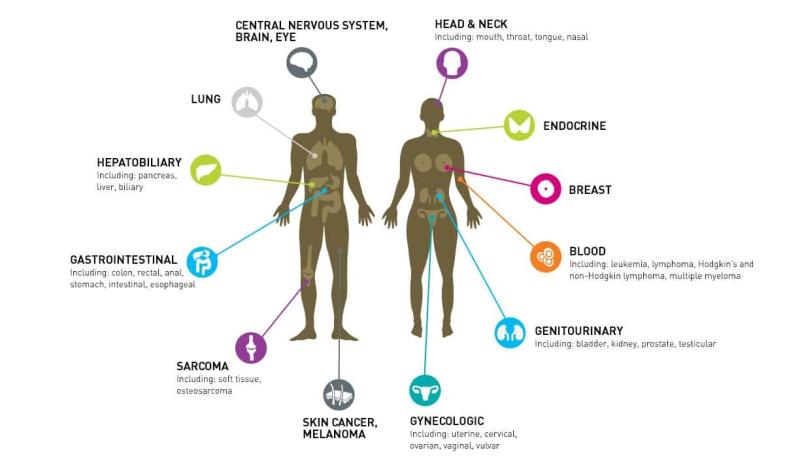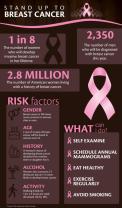What are the different types of cancer tumors?
Cancer is a complex and diverse group of diseases characterized by the uncontrolled growth and spread of abnormal cells. Tumors, or neoplasms, are one of the hallmarks of cancer. Tumors can be classified into two main types: benign and malignant.
1. Benign Tumors:
- Characteristics:
- Benign tumors are non-cancerous growths.
- They do not invade nearby tissues or spread to other parts of the body (metastasize).
- Typically have a well-defined border or capsule.
- Cells in benign tumors resemble normal cells.
- Examples:
- Adenomas (e.g., adenomas in the colon or pituitary gland).
- Fibromas (e.g., uterine fibroids).
- Lipomas (fatty tumors).
- Treatment:
- Benign tumors are usually not life-threatening.
- Treatment may involve surgical removal if the tumor causes symptoms or concerns.
2. Malignant Tumors:
- Characteristics:
- Malignant tumors are cancerous and can invade nearby tissues and organs.
- They have the potential to metastasize, spreading cancer cells to other parts of the body through the blood or lymphatic system.
- Cells in malignant tumors often have abnormal features and may vary in appearance.
- Examples:
- Carcinomas (e.g., lung, breast, colon cancers).
- Sarcomas (e.g., osteosarcoma, leiomyosarcoma).
- Leukemias and lymphomas (affecting the blood and lymphatic system).
- Treatment:
- Treatment for malignant tumors often involves a combination of surgery, chemotherapy, radiation therapy, immunotherapy, and targeted therapies.
- Treatment plans depend on the type and stage of cancer.
Classification Based on Tissue Type:
Carcinomas:
- Origin: Arise from epithelial tissues that cover the body's surfaces and line internal organs.
- Examples: Breast carcinoma, lung carcinoma, prostate carcinoma.
Sarcomas:
- Origin: Arise from connective tissues such as bones, muscles, cartilage, and blood vessels.
- Examples: Osteosarcoma (bone), leiomyosarcoma (smooth muscle), liposarcoma (fat tissue).
Leukemias:
- Origin: Arise from blood-forming tissues, primarily the bone marrow and blood.
- Examples: Acute lymphoblastic leukemia (ALL), chronic myeloid leukemia (CML).
Lymphomas:
- Origin: Arise from lymphocytes (a type of immune cell) and affect lymph nodes and lymphatic tissues.
- Examples: Hodgkin lymphoma, non-Hodgkin lymphoma.
Central Nervous System (CNS) Tumors:
- Origin: Arise in the brain or spinal cord.
- Examples: Glioblastoma multiforme, medulloblastoma.
Other Classifications:
Hormone Receptor-Positive or -Negative:
- Some cancers, like breast and prostate cancer, may be classified based on hormone receptor status.
HER2-Positive or -Negative:
- Some breast and gastric cancers may be classified based on human epidermal growth factor receptor 2 (HER2) status.
Grading and Staging:
- Tumors are often graded based on how closely they resemble normal tissue and staged based on the extent of spread.
Solid Tumors vs. Hematologic (Blood) Cancers:
- Cancers are broadly categorized into solid tumors and hematologic cancers based on whether they primarily affect solid tissues or the blood and lymphatic system.
It's important to note that within each broad category, there are numerous specific types of cancer, each with its own characteristics, behavior, and treatment options. Cancer is a complex and evolving field, and ongoing research continues to refine our understanding of different cancer types and improve treatment outcomes.
Sure, here is a detailed analysis of the categorization, major types, and characteristics of cancer tumors:
Categorization of cancer tumors: Understanding the classification system for different types of cancer
Cancer is a complex and diverse group of diseases characterized by the uncontrolled growth and spread of abnormal cells. To effectively manage and understand cancer, it is essential to classify different types of tumors based on their characteristics and origins. The World Health Organization (WHO) Classification of Tumours is the internationally recognized standard for classifying tumors. It provides a comprehensive framework for categorizing tumors based on their:
Histology: The microscopic structure of the tumor tissue, which reflects the type of cell from which the tumor originated.
Cytology: The cellular features of the tumor cells, such as their size, shape, and arrangement.
Behavior: The aggressiveness of the tumor, including its potential to invade surrounding tissues and metastasize to distant sites.
This classification system allows for a more precise diagnosis and prognosis for cancer patients, enabling tailored treatment approaches and improved patient outcomes.
Major types of cancer tumors: Exploring the diverse range of cancer entities
Cancer can arise from almost any cell type in the body, resulting in a vast array of different cancer entities. Some of the most common major types of cancer tumors include:
Carcinomas: Cancers that originate from epithelial cells, which line the surfaces of organs and glands, such as breast cancer, lung cancer, and colon cancer.
Sarcomas: Cancers that arise from connective tissues, including bones, muscles, cartilage, and fat, such as bone cancer, soft tissue sarcoma, and Kaposi's sarcoma.
Leukemias: Cancers of the blood cells, characterized by the uncontrolled production of abnormal white blood cells, such as acute myeloid leukemia and acute lymphocytic leukemia.
Lymphomas: Cancers of the lymphatic system, which is responsible for producing and transporting immune cells, such as Hodgkin's lymphoma and non-Hodgkin's lymphoma.
Myeloma: Cancer of the plasma cells, which are responsible for producing antibodies, a type of immune protein.
Characteristics and behavior of different cancer tumors: Delving into the specific aspects of various cancer types
Each type of cancer tumor has its own unique characteristics and behavior, influencing its diagnosis, treatment, and prognosis. Some of the key characteristics that differentiate cancer tumors include:
Site of origin: The specific organ or tissue where the tumor first develops.
Tumor type: The histological and cytological classification of the tumor cells.
Grade: The degree of differentiation of the tumor cells, ranging from well-differentiated (similar to normal cells) to poorly differentiated (anaplastic).
Stage: The extent of tumor progression, including the size of the tumor, invasion of surrounding tissues, and metastasis to distant sites.
Molecular characteristics: The genetic and epigenetic alterations that drive tumor growth and progression.
Understanding the characteristics and behavior of different cancer tumors is crucial for developing effective treatment strategies and improving patient outcomes.













